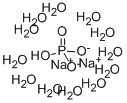2-PHOSPHOENOL PYRUVATE NA3SALT
- CAS NO.:5541-93-5
- Empirical Formula: C3H2Na3O6P
- Molecular Weight: 233.99
- MDL number: MFCD00044918
- EINECS: 226-906-8
- SAFETY DATA SHEET (SDS)
- Update Date: 2024-12-18 14:07:02

What is 2-PHOSPHOENOL PYRUVATE NA3SALT?
Chemical properties
white to almost white powder
The Uses of 2-PHOSPHOENOL PYRUVATE NA3SALT
When coupled with pyruvate kinase it completes an ATP-regenerating system
The Uses of 2-PHOSPHOENOL PYRUVATE NA3SALT
Phospho(enol)pyruvic acid trisodium salt hydrate has been used in:
- several enzyme activity assays, such as PRPP synthetase (PRPPS) assay, ribokinase (RK) assay, adenine phosphoribosyltransferase (APRT) assay
- in the reaction mixture for enzyme kinetic assay to determine platelet-derived growth factor receptor α (PDGFRA) kinetic parameters
- as a component in buffer B to react with adenosine diphosphate (ADP) to form adenosine triphosphate (ATP) for energy charge measurement
What are the applications of Application
Phosphoenolpyruvic acid, trisodium salt heptahydrate is a compound used in the biosynthesis of many other substances
Biochem/physiol Actions
Phosphoenolpyruvic acid plays a major role in the initial step of glycolysis by acting as an inhibitor of hexokinase, phosphoglucose isomerase, phosphofructokinase and aldolase.
Properties of 2-PHOSPHOENOL PYRUVATE NA3SALT
| Melting point: | 33-37°C |
| storage temp. | −20°C |
| solubility | H2O: 0.1 g/mL, clear to slightly turbid, colorless |
| form | Powder |
| CAS DataBase Reference | 5541-93-5 |
| EPA Substance Registry System | 2-Propenoic acid, 2-(phosphonooxy)-, trisodium salt (5541-93-5) |
Safety information for 2-PHOSPHOENOL PYRUVATE NA3SALT
| Signal word | Warning |
| Pictogram(s) |
 Exclamation Mark Irritant GHS07 |
| GHS Hazard Statements |
H315:Skin corrosion/irritation H319:Serious eye damage/eye irritation H335:Specific target organ toxicity, single exposure;Respiratory tract irritation |
| Precautionary Statement Codes |
P261:Avoid breathing dust/fume/gas/mist/vapours/spray. P264:Wash hands thoroughly after handling. P264:Wash skin thouroughly after handling. P271:Use only outdoors or in a well-ventilated area. P280:Wear protective gloves/protective clothing/eye protection/face protection. P302+P352:IF ON SKIN: wash with plenty of soap and water. P305+P351+P338:IF IN EYES: Rinse cautiously with water for several minutes. Remove contact lenses, if present and easy to do. Continuerinsing. |
Computed Descriptors for 2-PHOSPHOENOL PYRUVATE NA3SALT
New Products
4-Fluorophenylacetic acid 4-Methylphenylacetic acid N-Boc-D-alaninol N-BOC-D/L-ALANINOL Tert-butyl bis(2-chloroethyl)carbamate 3-Morpholino-1-(4-nitrophenyl)-5,6-dihydropyridin- 2(1H)-one Furan-2,5-Dicarboxylic Acid Tropic acid S-2-CHLORO PROPIONIC ACID ETHYL ISOCYANOACETATE 2-Bromo-1,3-Bis(Dimethylamino)Trimethinium Hexafluorophosphate (6-METHYL-[1,3]DITHIOLO[4,5-b]QUINOXALIN-2-ONE INDAZOLE-3-CARBOXYLIC ACID 4-IODO BENZOIC ACID (2-Hydroxyphenyl)acetonitrile 4-Bromopyrazole 5,6-Dimethoxyindanone 2-(Cyanocyclohexyl)acetic acid 4-methoxy-3,5-dinitropyridine 2-aminopropyl benzoate hydrochloride 1-(4-(aminomethyl)benzyl)urea hydrochloride diethyl 2-(2-((tertbutoxycarbonyl)amino) ethyl)malonate tert-butyl 4- (ureidomethyl)benzylcarbamate Ethyl-2-chloro((4-methoxyphenyl)hydrazono)acetateRelated products of tetrahydrofuran




![2-[PHOSPHONOOXY]-2-PROPENOIC ACID TRISODIUM SALT HYDRATE](https://img.chemicalbook.in/StructureFile/ChemBookStructure2/GIF/CB4270678.gif)



You may like
-
 Phospho(enol)pyruvic acid trisodium salt hydrate CAS 5541-93-5View Details
Phospho(enol)pyruvic acid trisodium salt hydrate CAS 5541-93-5View Details
5541-93-5 -
 2033-24-1 98%View Details
2033-24-1 98%View Details
2033-24-1 -
 1975-50-4 98%View Details
1975-50-4 98%View Details
1975-50-4 -
 2-HYDROXY BENZYL ALCOHOL 98%View Details
2-HYDROXY BENZYL ALCOHOL 98%View Details
90-01-7 -
 2-Chloro-1,3-Bis(Dimethylamino)Trimethinium Hexafluorophosphate 221615-75-4 98%View Details
2-Chloro-1,3-Bis(Dimethylamino)Trimethinium Hexafluorophosphate 221615-75-4 98%View Details
221615-75-4 -
 61397-56-6 CIS BROMO BENZOATE 98%View Details
61397-56-6 CIS BROMO BENZOATE 98%View Details
61397-56-6 -
 14714-50-2 (2-Hydroxyphenyl)acetonitrile 98+View Details
14714-50-2 (2-Hydroxyphenyl)acetonitrile 98+View Details
14714-50-2 -
 118753-70-1 98+View Details
118753-70-1 98+View Details
118753-70-1
Statement: All products displayed on this website are only used for non medical purposes such as industrial applications or scientific research, and cannot be used for clinical diagnosis or treatment of humans or animals. They are not medicinal or edible.